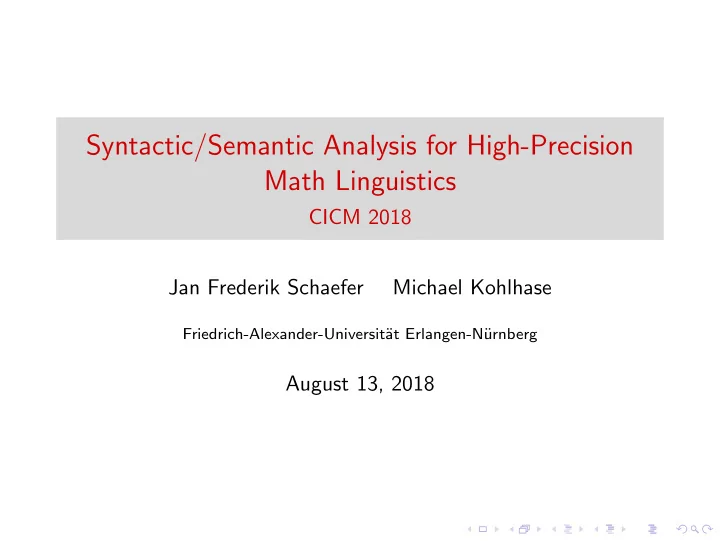

Syntactic/Semantic Analysis for High-Precision Math Linguistics CICM 2018 Jan Frederik Schaefer Michael Kohlhase Friedrich-Alexander-Universit¨ at Erlangen-N¨ urnberg August 13, 2018
Example “ A positive integer n is called prime, iff there is no integer 1 < m < n such that m | n ” Translation to (from) German: “ Eine positive ganze Zahl n ist prim genau dann, wenn es keine ganze Zahl 1 < m < n gibt, sodass m | n ” Formalization: ∀ n . pos ( n ) ∧ int ( n ) ⇒ ( prime ( n ) ⇔ ¬∃ m . int ( m ) ∧ divides ( m , n ) ∧ less (1 , m ) ∧ less ( m , n ))
GF - Grammatical Framework • “A programming language for multilingual grammar applications” • Natural language as formal language ⇒ limited coverage but high precision • Idea: • Abstract grammar describes “meaning” we want to express • Concrete grammars describe how this is expressed in English/German/Logic/...
Abstract Grammar abstract Gossip = { cat O; −− p r o p o s i t i o n s I ; −− i n d i v i d u a l s fun John , Mary : I ; Love : I − > I − > O; And O : O − > O − > O; And I : I − > I − > I ; } Example: And O (Loves John Mary) (Loves John John)
Abstract Grammar
Concrete Grammar
Concrete Grammar - Simple Approach concrete GossipStr of Gossip = { lincat I = Str ; O = Str ; lin John = ”John” ; Mary = ”Mary” ; Love a b = a ++ ” loves ” ++ b ; And O a b = a ++ ”and” ++ b ; And I a b = a ++ ”and” ++ b ; } Problem: “ John and Mary loves John ”
Concrete Grammar - Simple Approach Problem: Ending of verb depends on subject • Idea: Use record types • This is a common problem � GF’s resource grammar library
Concrete Grammar - Resource Grammar Library concrete GossipEng of Gossip = open SyntaxEng , ParadigmsEng i n { l i n c a t I = NP; − − noun phrase O = S ; − − sentence l i n John = mkNP (mkPN ”John” ) ; Mary = mkNP (mkPN ”Mary” ) ; Love a b = mkS ( mkCl a (mkV2 ” l o v e ” ) b ) ; And O a b = mkS and Conj a b ; And I a b = mkNP and Conj a b ; }
Concrete Grammar - Translation “ Johann liebt Maria und Johann liebt Johann ” ↓ ↓ “ John loves Mary and John loves John ”
Using GF for Mathematics - Challenges • Parsing formulae • Different grammatical roles of formulae in a sentence • “ if n > 1” • “ if n + k is even ” • Other idiosyncracies in mathematical language not covered by the resource grammar library, like • “ let n be a. . . ” • “ an integer is called prime iff. . . ” • Finding the right abstract grammar (syntactic vs semantic)
Using GF for Mathematics - Formula as Statement “ we know that n > 2”
Using GF for Mathematics - Formula as Identifier “ let n > 2 be an integer ”
Using GF for Mathematics - Using Identifier in Statement “ there is an integer n such that . . . ”
Using GF for Mathematics - Using Identifier in Statement “ there is an integer n such that . . . ” exists suchthat : PosNegPol − > MObj − > Identifier − > StatementFin − > StatementFin; ( ∃ n . ( λ x . int ( x )) n ∧ ( . . . )) ↓ β ∃ n . int ( n ) ∧ . . .
Using GF for Mathematics - Using Identifier in Statement “ there isn’t a positive integer n > 2 such that . . . ” exists suchthat : PosNegPol − > MObj − > Identifier − > StatementFin − > StatementFin; ( ¬∃ n . ( λ x . pos ( x ) ∧ int ( x )) n ∧ greater ( n , 2) ∧ ( . . . )) ↓ β ¬∃ n . pos ( n ) ∧ int ( n ) ∧ greater ( n , 2) , ∧ . . .
Using GF for Mathematics - Example “ A positive integer n is called prime, iff there is no integer 1 < m < n such that m | n ” Translation to (from) German: “ Eine positive ganze Zahl n ist prim genau dann, wenn es keine ganze Zahl 1 < m < n gibt, sodass m | n ” Formalization: ( ∀ n . (( λ x . pos ( x ) ∧ int ( x )) n ) ⇒ (( λ x . prime ( x )) n ⇔ ( ¬∃ m . ( λ x . int ( x )) m ∧ less (1 , m ) ∧ less ( m , n ) ∧ ( divides ( m , n ))))) ↓ β ∀ n . pos ( n ) ∧ int ( n ) ⇒ ( prime ( n ) ⇔ ¬∃ m . int ( m ) ∧ divides ( m , n ) ∧ less (1 , m ) ∧ less ( m , n ))
Next Steps • Extend grammars for larger coverage • Extend lexica for larger coverage • Switch to DRT
Recommend
More recommend